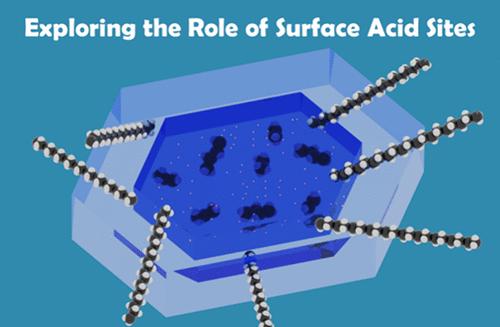了解 MFI 沸石表面酸度在低密度聚乙烯裂解过程中的作用:分解温度和产物分布
IF 11.3
1区 化学
Q1 CHEMISTRY, PHYSICAL
引用次数: 0
摘要
在塑料催化裂解过程中利用沸石作为一种前景广阔的回收方法已引起人们的关注。沸石微孔均匀且具有形状选择性,但与聚合物分子相比,其尺寸非常小。因此,发生在沸石外表面和孔口附近的反应对聚合物裂解至关重要。然而,沸石表面在聚合物裂解中的作用尚未明确。在本研究中,我们控制了沸石的外表面(粒度、外表面积和表面酸位点的位置)。这些催化剂被用于低密度聚乙烯(LDPE)的裂解,并研究了其表面特性对反应的影响。通过改变 ZSM-5 沸石的粒度和脱硅条件来控制其外表面积。虽然低密度聚乙烯的裂解温度在很大程度上取决于沸石的表面积,但当外表面积超过约 90 m2/g 时,温度就会趋于稳定。为了进一步研究表面酸度的作用,我们制备了不同壳厚度的核壳型 ZSM-5/ 硅胶-1 沸石。硅铝酸盐-1涂层明显降低了ZSM-5沸石的低密度聚乙烯裂解活性,裂解温度随硅铝酸盐-1外壳厚度的增加而升高。然而,随着惰性壳厚度的增加,气态产物分布向低碳氢化合物转移,这表明外部酸性位点的初始裂解和过度反应导致产生大量的 C5 和 C6+ 产物。这项研究揭示了最初的裂解反应发生在孔口附近的内部酸性位点以及外部表面,较小的反应物扩散到深层活性位点。预计这些发现将为开发适用于聚合物催化裂解的沸石催化剂提供有价值的见解。本文章由计算机程序翻译,如有差异,请以英文原文为准。

Understanding the Role of the Surface Acidity of MFI Zeolites during LDPE Cracking: Decomposition Temperature and Product Distribution
The utilization of zeolites in the catalytic cracking of plastics has garnered attention as a promising recycling method. Zeolitic micropores are uniform and exhibit shape selectivity, but their sizes are very small compared to those of polymer molecules. Consequently, the reactions occurring on the external surfaces and near the pore mouths of zeolites are crucial for polymer cracking. However, the role of zeolitic surfaces in polymer cracking has not been clarified. In this study, we controlled the external surfaces of zeolites (particle size, external surface areas, and location of the surface acid sites). These catalysts were employed in the cracking of low-density polyethylene (LDPE), and the effects of their surface properties on the reactions were investigated. The external surface areas of ZSM-5 zeolites were controlled by changing their particle sizes and desilication conditions. Although the LDPE cracking temperatures strongly depended on the zeolitic surface area, the temperature was plateaued when the external surface area exceeded approximately 90 m2/g. To investigate the role of surface acidity further, we prepared core–shell-type ZSM-5/silicalite-1 zeolites with various shell thicknesses. The silicalite-1 coating significantly reduced the LDPE cracking activity of ZSM-5 zeolites, and the cracking temperature increased with the increase in silicalite-1 shell thickness. However, the gaseous product distributions were shifted toward lower hydrocarbons by the increase in inert shell thickness, indicating that the initial cracking and excessive reactions on the external acid sites led to the production of large C5 and C6+ products. This study revealed that the initial cracking reactions occur at the inner acid sites near the pore mouth as well as the external surface and that the smaller reactants diffuse into deep active sites. These findings are anticipated to offer valuable insights into the development of zeolite catalysts suitable for the catalytic cracking of polymers.
求助全文
通过发布文献求助,成功后即可免费获取论文全文。
去求助
来源期刊

ACS Catalysis
CHEMISTRY, PHYSICAL-
CiteScore
20.80
自引率
6.20%
发文量
1253
审稿时长
1.5 months
期刊介绍:
ACS Catalysis is an esteemed journal that publishes original research in the fields of heterogeneous catalysis, molecular catalysis, and biocatalysis. It offers broad coverage across diverse areas such as life sciences, organometallics and synthesis, photochemistry and electrochemistry, drug discovery and synthesis, materials science, environmental protection, polymer discovery and synthesis, and energy and fuels.
The scope of the journal is to showcase innovative work in various aspects of catalysis. This includes new reactions and novel synthetic approaches utilizing known catalysts, the discovery or modification of new catalysts, elucidation of catalytic mechanisms through cutting-edge investigations, practical enhancements of existing processes, as well as conceptual advances in the field. Contributions to ACS Catalysis can encompass both experimental and theoretical research focused on catalytic molecules, macromolecules, and materials that exhibit catalytic turnover.
 求助内容:
求助内容: 应助结果提醒方式:
应助结果提醒方式:


